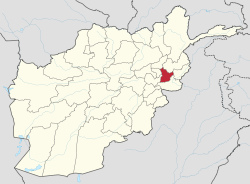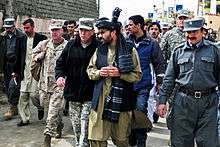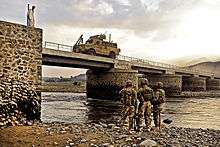Laghman Province
| Laghman لغمان | |
|---|---|
| Province | |
|
Lush greenery stands in stark contrast to the surrounding desert in Laghman Province | |
 Map of Afghanistan with Laghman highlighted | |
| Coordinates (Capital): 34°40′N 70°12′E / 34.66°N 70.20°ECoordinates: 34°40′N 70°12′E / 34.66°N 70.20°E | |
| Country |
|
| Capital | Mihtarlam |
| Government | |
| • Governor | Dr Abdul Jabbar Naeemi |
| Area | |
| • Total | 3,842.6 km2 (1,483.6 sq mi) |
| Population (2015)[1] | |
| • Total | 445,588 |
| • Density | 120/km2 (300/sq mi) |
| Time zone | UTC+4:30 |
| ISO 3166 code | AF-LAG |
| Main languages |
Pashto Dari Pashayi |
Laghman (Pashto/Persian: لغمان) is one of the 34 provinces of Afghanistan, located in the eastern part of the country. It has a population of about 445,600,[1] which is multi-ethnic and mostly a rural society. The city of Mihtarlam serves as the capital of the province. In some historical texts the name is written as "Lamghan" or as "Lamghanat".
History

Located currently at the Kabul Museum are Aramaic inscriptions that were found in Laghman which indicated an ancient trade route from India to Palmyra.[2] Aramaic was the bureaucratic script language of the Achaemenids whose influence had extended toward Laghman.[3] During the invasions of Alexander the Great, the area was known as Lampaka.[4]
Inscriptions in Aramaic dating from the Mauryan Dynasty were found in Laghman which discussed the conversion of Ashoka to Buddhism.[5]
In the seventh century, the Chinese pilgrim Xuanzang visited Laghman, which he called "Lan-p'o" and considered part of India. He indicated the presence of Mahayana Buddhists and numerous Hindus:
"For several centuries the native dynasty had ceased to exist, great families fought for preeminence, and the state had recently become a dependency of Kapis. The country produced upland rice and sugar-cane, and it had much wood but little fruit; the climate was mild with little frost and no snow. [...] There were above ten Buddhist monasteries and a few Brethren the most of whom were Mahayanists. The non-Buddhists had a score or two of temples and they were very numerous."[6]
By the tenth century, Laghman was still connected to the Greater Indian world. Hudud al-'alam which was finished in 982 AD mentioned the presence of some idol worshipping temples in the area.[7] According to Muslim historian al-Utbi, the region was converted to Islam towards the end of the tenth century by the Ghaznavids, led by Abu Mansur Sabuktigin:
"The Amir marched out towards Lamghan, which is a city celebrated for its great strength and abounding in wealth. He conquered it and set fire to the places in its vicinity which were inhabited by infidels, and demolishing the idol-temples, he established Islam in them, He marched and captured other cities and killed the polluted wretches, destroying the idolatrous and gratifying the Musulmans. After wounding and killing beyond all measure, his hands and those of his friends became cold in counting the value of the plundered property. On the completion of his conquest he returned and promulgated accounts of the victories obtained for Islam, and every one, great and small, concurred in rejoicing over this result and thanking God."[8]
Sabuktigin then won one of his greatest battles in Laghman against the Hindu Shahis whose ruler, Jayapala, had amassed an army for the battle that numbered 100,000.[9] The area later fell to the Ghurids followed by the Khilis and Timurids.
During the early years of the 16th century, the Mughal ruler Babur spent much time in Laghman, and in Baburnama (memoirs of Babur) he expatiated on the beauty of forested hillsides and the fertility of the valley bottoms of the region.[7] Laghman was recognized as a dependent district of Kabulistan in the Mughal era,[10] and according to Baburnama, "Greater Lamghanat" included the Muslim-settled part of the Kafiristan, including the easterly one of Kunar River. Laghman was the base for expeditions against the non-believers and was frequently mentioned in accounts of jihads led by Mughal emperor Akbar's younger brother, Mohammad Hakim, who was the governor of Kabul.[7] In 1747, Ahmad Shah Durrani defeated the Mughals and made the territory part of the Durrani Empire. In the late nineteenth century, Amir Abdur Rahman Khan forced the remaining kafirs (Nuristani people) to accept Islam.
Recent history

During the Soviet-Afghan war and the battles that followed between the rivaling warlords, many homes and business establishments in the province were destroyed. In addition, the Soviets are said to have employed a strategy that targeted and destroyed the agricultural infrastructure of Laghman.[11]
As of 2007, an International Security Assistance Force Provincial Reconstruction Team led by the United States is based at Mihtarlam.
Politics and governance
The current governor of the province is Fazlullah Mujadedi. The city of Mihtarlam is the capital of the province. All law enforcement activities throughout the province are controlled by the Afghan National Police (ANP). The provincial police chief represents the Ministry of the Interior in Kabul. The ANP is backed by other Afghan National Security Forces (ANSF), including the National Directorate of Security (NDS) and NATO-led forces.
Healthcare
The percentage of households with clean drinking water fell from 39% in 2005 to 34% in 2011.[12] The percentage of births attended to by a skilled birth attendant increased from 3% in 2005 to 36% in 2011.[12]
Education
The overall literacy rate (6+ years of age) increased from 14% in 2005 to 26% in 2011.[12] The overall net enrolment rate (6–13 years of age) increased from 48% in 2005 to 52% in 2011.[12]
Demography


The total population of the province is about 424,100, which is multi-ethnic and mostly a rural society.[1] According to the Naval Postgraduate School, the ethnic groups of the province are as follows: 51% Pashtun, 21% Tajik, 27% Pashai and Nuristani (Kata).[13][14] The people of Laghman are overwhelmingly Sunni Muslim.
Districts
| District | Capital | Population (2015) | Area[15] | Notes |
|---|---|---|---|---|
| Alingar | 98,764 | |||
| Alishing | 72,844 | |||
| Dawlat Shah | 33,962 | |||
| Mihtarlam | Mihtarlam | 132,374 | ||
| Qarghayi | 100,084 | |||
| Badpash | 7,560 |
Notable people from this province
- Mirwais Azizi the founder and the owner of Azizi Bank
- Dr. Mohammad Shafiq Hamdam a prominent social activist for promoting peace, justice and human rights.
- Abdul Zahir – Prime Minister of Afghanistan in the 1970s.
- Abdul Khaliq Hussaini Pashai Former Senator 2005
- Mohammad Hanif Atmar – Former Interior Minister of Afghanistan 2010.
- Abdullah Laghmani - Former Deputy Intelligence Officer of Afghanistan 2009.
- Gul Pacha Ulfat-prominent poet and writer
- Ahmad Zahir-well known singer and songwriter
- Hafizullah Khaled - Public Figure, Peace promoting activist, and defender of Afghan children rights.
- Zalmay Khalilzad American-Afghan statesman, diplomat and businessmana
- Dr. Hafiz Sahar U.S. educated journalism professor, deputy minister, president of Islah Newspaper
Infrastructure and economy

The Alingar and Alinshang rivers pass through Laghman, as the province is known for its lushness. Laghman has sizable amounts of irrigated land as one can find scores of fruits and vegetables from Laghman in Kabul. Other main crops in Laghman include rice, wheat and cotton as many people living in the area are involved in agricultural trade and business.
Laghman also has an array of precious stones and minerals,[16] as it is well known for being a relatively untapped source of the Tourmaline and Spodumene gemstones which are reported to be in abundance at the northern portions of the province.[17]
See also
References
- 1 2 3 "Settled Population of Laghman province by Civil Division, Urban, Rural and Sex-2012-13" (PDF). Islamic Republic of Afghanistan, Central Statistics Organization. Retrieved 2013-06-17.
- ↑ Cultural policy in Afghanistan; Studies and documents on cultural policies; 1975
- ↑ "AŚOKA". iranicaonline.org.
- ↑ The Aramaic Inscription of Asoka Found in Lampāka
- ↑ Kurt A. Behrend. Handbuch Der Orientalistik: India. The Buddhist Architecture of Gandhara, Part 2, Volume 1. p. 39.
- ↑ Thomas Watters (1904). On Yuan Chwang's travels in India, 629-645 A.D. Royal Asiatic Society.
- 1 2 3 Annemarie Schimmel. "Islam in India and Pakistan". In CE Bosworth, E van Donzel, B Lewis, Ch. Pellet. The Encyclopaedia of Islam, Volume V. p. 649. ISBN 90-04-07819-3.
- ↑ Sir H. M. Elliot (1869). "Chapter II, Tarikh Yamini or Kitabu-l Yamini by Al Utbi". The History of India, as Told by Its Own Historians. The Muhammadan Period. Trubner and Co. p. 22.
- ↑ The History of India: The Hindu and Mahometan Periods, Mountstuart Elphinstone, p. 321.
- ↑ The Garden of Eight Paradises: Babur and the Culture of Central Asia, Afghanistan
- ↑ How the Weak Win Wars: A Theory of Asymmetric Conflict, Arreguin-Toft, pg. 186
- 1 2 3 4 Archive, Civil Military Fusion Centre, https://www.cimicweb.org/AfghanistanProvincialMap/Pages/Laghman.aspx
- ↑ http://www.nps.edu/programs/ccs/Docs/Executive%20Summaries/Laghman_Exec_Summary1.pdf
- ↑ "Laghman Province". Program for Culture & Conflict Studies. Naval Postgraduate School. Retrieved 2013-06-16.
- ↑ Afghanistan Geographic & Thematic Layers
- ↑ "Pegmatites of Laghman, Nuristan, Afghanistan". palagems.com.
- ↑ Gemstones of Afghanistan, Chamberline, pg. 146
External links
| Wikimedia Commons has media related to Laghman Province. |
 |
Panjshir Province | Nuristan Province |  | |
| Kapisa Province | |
Kunar Province | ||
| ||||
| | ||||
| Kabul Province | Nangarhar Province |

